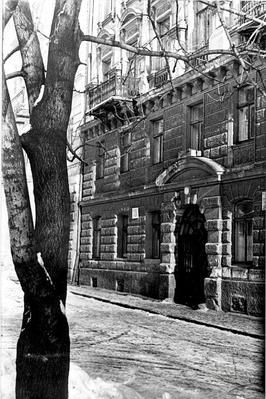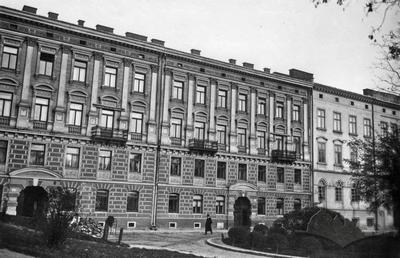Vul. Vynnychenka, 26 – residential building ID: 2364
This residential apartment building was built in 1879-1880 by architect Michał Fechter in Neo-Renaissance style. In 1898-1939 the building was owned by the Shevchenko Scientific Society; in the Soviet period it was adapted for dwelling. It is an architectural monument of local significance (protection number 426).
Story
Mid-17th
c. – a yard of the Discalced
Carmelite nuns with utility buildings is constructed.
1784 – the estate of the Discalced
Carmelite nuns is transferred to the fund of religious assets (after the
abolition of the convent).
1786 – the Carmelite nuns' yard is passed to Jakub
Walker, a Lviv cartwright.
1802 – the yard under conscription
number 2 4/4 (now house number vul. Vynnychenka, 26)
is bought from Jakub Walker by Kasper and Elisabeth Sacherl.
1865 – the old two-tier house is reconstructed.
1876 – a project of a three-storied townhouse is
designed by architect Michał Fechter (not implemented).
1879 – a project of a four-storied
townhouse is designed by architect Michał Fechter; the old house is dismantled;
the left half of the house is built.
1880 – the other (right) half of the
townhouse is built (architect Michał Fechter).
1896 – the orientation number is
replaced with the contemporary one (26).
1898 – the residential townhouse on
Czarneckiego street 26 is bought by the Shevchenko Scientific Society.
1912 – a reconstruction of the wing
is carried out by the Society to adapt it for its printshop (architects
Włodzimierz Podhorodecki, Ivan Levynskyi/Jan
Lewiński).
2000s – commemorative plaques,
dedicated to some prominent Ukrainian figures of science, culture, and arts,
who lived in the building of the Shevchenko Scientific Society, are installed
on the façade.
The house is located east of the city’s historic center, in the row housing of Vynnychenka street. This plot, like that of the neighboring corner house (№24), belonged to the Discalced Carmelite nuns' convent, which was founded in 1642 by Jakub Sobieski, the father of Polish king Jan III Sobieski, the Ruthenian voivode and the castellan of Krakow, who had his court there. It was from his name that the hilly area between contemporary Kryvonosa, Vynnychenka, Lysenka, and Hutsulska streets was called Sobieszczyzna in the 17th and 18th centuries. Sobieski granted the land, located within these streets, to the convent. By the second half of the 18th century, there was the Carmelite nuns' yard with farm buildings on the hills.
After the abolition of the convent in 1784, its estate, as well as many other estates belonging to Galician monasteries and convents abolished due to the Emperor Joseph's reform, was transferred to the fund of religious assets. In 1786 the Carmelite nuns' yard, located directly at the walls of their convent, was transferred by the Lviv Directorate of the sacral property to the possession of Jakub Walker, a Lviv cartwright. This property, together with the ground, was 5700 square cubits large. In 1802 the yard under conscription number 2 4/4 (now vul. Vynnychenka, 26) was bought from Jakub Walker by Kasper and Elżbieta Zacherl. After the death of Kasper in 1812 the estate passed to his wife Elżbieta who later divided it between her children Leopold and Dorota.
in 1865 Leopold Zacherl, a Lviv merchant, sold his property to Leopold Haberman. That same year Haberman had the old two-storied house reconstructed. On 17 October 1875 Leopold Haberman sold his property to Piotr Wajda, a member of the Lviv city council (construction department), and to his wife Honorata. The following year, Piotr Wajda began a reconstruction of the old house and commissioned Michał Fechter, a Lviv architect, to design a project; however, the project of a three-storied townhouse, approved in 1876, was not implemented. In 1879 Fechter designed a new project for Wajda, this time of a four-storied townhouse with a mezzanine, approved by the Magistrate on 29 September of the same year. First, as the site plan shows, the new townhouse's left half was being built while the old house was being dismantled. In 1880 the same architect designed a project of the other (right) half of the townhouse. Designed by Fechter in Neo-Renaissance style, the building with its magnificent architectural decoration was constructed without any changes. Its current condition corresponds to the author's project. The house was completed in the same year, and in December Wajda got the Magistrate's permission to settle it. As of that time, the house on Czarneckiego street had the number 28, but, at Wajda’s request, in 1896 it was replaced with the contemporary number 26.
Two years later the townhouse was bought from Piotr and Honorata Wajda by the Shevchenko Scientific Society. The contract of sale dated 5 August 1898 was signed on behalf of the Shevchenko Scientific Society by Dr. Yevhen Ozarkevych and Dr. Kost Levytskyi. The cost of the purchased house was 240 thousand crowns. A considerable part of the funds for the purchase of this property was granted by professor Pelekhin. Initially, the house was occupied by all institutions of the Society, including the administration, a library, a museum, editorial offices of the "Memoirs of the Shevchenko Scientific Society" and of the "Literary and Scientific Bulletin", a printshop and book stores.
In 1912 the Society carried out a reconstruction of the wing to adapt it for their printshop (architects Włodzimierz Podhorodecki, Ivan Levynskyi/Jan Lewiński). The Society rented out the house to officials.
At different times the two houses of the Shevchenko Scientific Society (nn. 24, 26) were inhabited by prominent figures of Ukrainian science, culture, and art, including Mykhailo Hrushevskyi, Ivan Franko, Lesia Ukrainka, Vasyl Stefanyk, Borys Hrinchenko, Filaret Kolessa, Mykhailo Vozniak, Kyrylo Studynskyi, Yaroslava Muzyka, Ivan Trush, Stefan Kachala and many others. Commemorative plaques, dedicated to some of them, are installed on the façades.
In the Soviet period, the house was residential.
Architecture
The four-storied townhouse is located in the row housing of the street. It is built of brick and plastered, based on a square plan with a square courtyard. The main façade is designed in Neo-Renaissance style, with magnificent architectural decoration. The façade's composition is based on the symmetry principle: two arched gates accentuate the central axes of, respectively, two seven-axis symmetrical parts. The ground floor and the second floor are rusticated, divided by a cornice and accentuated by a developed massive cornice supported by modillions, where cast metal balconies are arranged, two in each section. The two upper floors are designed according to the order system. They are connected by Corinthian pilasters supporting an entablature with a molded arabesque frieze having attic windows. The rectangular windows are decorated with segmental pediments on the third floor and with linear pediments on the fourth floor; the ground floor windows are segmental. The building is topped with a cornice supported by modillions.
People
Michał Fechter — Lviv architect who designed the four-tiered townhouse where the Shevchenko
Scientific Society was accomodated later
Ivan Franko — Ukrainian writer, poet, publicist,
interpreter, scholar, public and political figure, Doctor of Philosophy, member of the Shevchenko Scientific Society
Leopold Habermann — owner of the real estate 2 4/4 in 1865–1875,
who commissioned a reconstruction of an old two-tiered house
Borys Hrinchenko — Ukrainian writer, pedagogist,
literature historian, ethnographer, historian, publicist, public and culture
figure
Mykhailo Hrushevskyi — history professor, organizer of
Ukrainian science, political figure, publicist, Head of the Central Сouncil of the Ukrainian People's
Republic, Head of the Shevchenko Scientific Society for many years
Jan III Sobieski — Polish king
Stefan Kachala — Greek-Catholic priest, political
and public figure, a Populist (Narodovets),
founder and member of the Shevchenko Scientific Society
Filaret Kolessa — ethnographer, folklorist, composer,
musicologist, literature historian, member of the Shevchenko Scientific Society
and of the All-Ukrainian Academy of Sciences, founder of Ukrainian ethnographic
musicology
Ivan Levynskyi (Jan Lewiński) — Ukrainian architect, pedagogist,
enterpreneur, public figure
Kost Levytskyi — renowned political figure in
Galicia, co-founder of Ukrainian
National-Democratic Party, scientist, founder and head of the National Council
in Lviv, publicist, member of Shevchenko Scientific Society
Yaroslava Muzyka — Ukrainian artist, restorator,
collectioner, public figure, who resided in the building
Yevhen Ozarkevych — doctor, director of the Shevchenko
Scientific Society's Medical Commission, founder of the People's Hospital (Narodna Lichnytsia) in 1903
Pelekhin — professor who donated considerable funds for the Shevchenko Scientific
Society to purchase the building
Włodzimierz Podhorodecki
— architect,
designed a reconstruction project of the building's wing to adapt it to a
printshop
Dorota Sacherl — co-owner of the real estate 2 4/4
Elżbieta Sacherl — owner of the real estate 2 4/4 in 1802–1812
Kasper Sacherl — owner of the real estate 2 4/4 after 1812
Leopold Sacherl — a Lviv merchant, co-owner of the
real estate 2 4/4 before 1865
Jakub Sobieski — Ruthenian voivode, castellan of Krakow, father of the Polish king
Jan III Sobieski, who founded a Discalced Carmelite nuns' convent with a church
of the Meeting of the Lord on the so-called Striletski
hills
Vasyl Stefanyk — Ukrainian writer, public figure,
politician, member of Austrian parliament representative of Galicia, resided in
the building
Kyrylo Studynskyi — Ukrainian philologist, Slavistics
scholar, literature historian, writer, public figure, Doctor of Philosophy,
member of All-Ukrainian
Academy of Sciences and of Shevchenko Scientific Society
Ivan Trush — Ukrainian Impressionist painter,
landscape artist and portraitist, art critique, organizer of artistic life in
Galicia
Lesia Ukrainka — Ukrainian writer, interpreter,
cultural figure, who resided in the building
Mykhailo Vozniak— Ukrainian literature historian and
folklorist, member of Shevchenko Scientific Society, academic of the Academy of
Sciences of Ukrainian SSR
Honorata Wajda — Piotr Wajda's wife, co-owner of
the real estate 2 4/4 in 1875–1898
Piotr Wajda — member of the Lviv City Council in
the construction department, owner of the real estate 2 4/4 in 1875–1898
Jakub Walker — Lviv cartwright, owner of the real
estate 2 4/4 in 1786–1802
Organizations
Sources
- State Archive of Lviv Oblast (DALO), item 2/2/3456
- Central State Historical Archives of Ukraine in Lviv (CDIAL), item 186/8/829
- Володимир Вуйцик, "До історії будинків Наукового Товариства ім. Шевченка. Вулиця В. Винниченка, 26", LeopolitanaII, (Львів: Класика, 2013), 212-215.
- Іван Крип’якевич, Історичні проходи по Львову (Львів: Каменяр, 1991).
- Світлана Лінда, "Архітектура історизму (40–90-і роки XIX ст.)", Архітектура Львова. Час і стилі XIII–XXI ст. (Львів: Центр Європи, 2008), 341-343.











